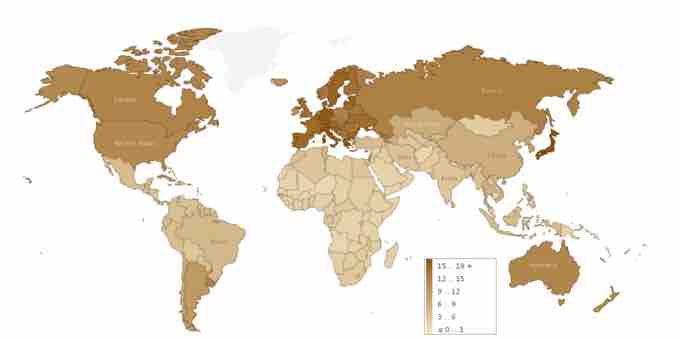Globally, most countries are seeing the average life expectancy of their populations increase. This trend translates to a greater percentage of the world's population over the age of 65. However, the rate at which the world's population is aging is not uniform across the world—some countries have actually seen decreasing life expectancies.
Economic circumstances are one factor that affects life expectancy. Citizens living in wealthier, more developed countries or regions tend to have higher life expectancies. For example, in the United Kingdom, life expectancy in the wealthiest areas is several years longer than in the poorest areas. Wealth may be correlated to factors such as diet and lifestyle as well as better access to medical care—many wealthy European countries offer universal healthcare. As more people in a nation's population reach old age, its healthcare and social security system will be strained. This strain is occurring in the United States, where people born into the baby boomer generation of the 1950s–1960s are aging and reaching retirement age, thus tapping into Medicaid and social security funds at unprecedented rates.
People living in poorer, less developed countries tend to have lower life expectancies. Much of the higher death rates in poorer nations is due to war, starvation, infant deaths, diseases, and lack of access to adequate health care. The presence of one risk factor is often related to another—war torn countries, for example, are likely to have more instances of starvation. Likewise, people with diseases may have a difficult time getting or sustaining a job, making them vulnerable to starvation. The impact of AIDS on life expectancy is particularly significant in many sub-Saharan African countries. As nations develop, their life expectancy generally rises.
Growing life expectancy is not the only factor contributing to global aging. As nations develop, the average number of children per parent drops. There are several possible reasons for this trend: first, in poorer countries, it may be important to have many children because infant mortality is high and children provide financial support for households and support for their parents in retirement. As a population gets richer, these reasons will become less important. Second, as women become more educated, they tend to delay having children until later in life. This naturally leads to fewer childbirths.
A drop in the birth rate means that the percentage of people in a society who are young will decline. This, combined with higher life expectancies, means that the ratio of old to young people will grow and the population as a whole will age. These two trends, stemming from the growing global economy, cause global aging.

Percentage of Population Above 65: 2005
This map illustrates global trends in aging by depicting the percentage of each country's population that is over the age of 65. More developed countries have older populations because their citizens live longer. Less developed countries have much younger populations.